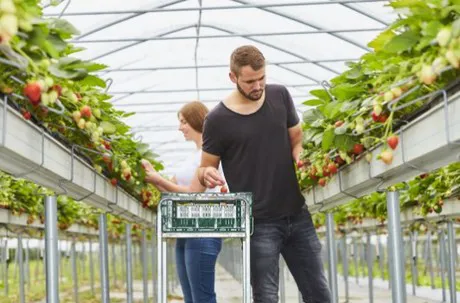Within professional cultivation, strawberries no longer just grow in the soil in the field. More and more often, growers also have them one floor up, on so-called racks. Doesn't it look appetizing though, when these red, juicy fruits are hanging down on either side of the troughs, at one meter high? It also makes it easier for the harvest workers to do the work, as German strawberries are still carefully picked by hand.

Picture: Das Grüne Medienhaus
Strawberry cultivation has a long tradition in Germany. There are family farms that are growing these tasty fruits already for a third or fourth generation. Still, much of the work is done by hand. "There is still no machine that manages to harvest the delicate strawberry fruits without damage," explains Ludger Linnemannstöns, an expert in strawberry cultivation from the Chamber of Agriculture of North Rhine-Westphalia. Only people manage to carefully pick the ripe, juicy and plump fruits and put them into the bowls.
Rack culture; this is the name of strawberry cultivation in a trough system that stands on supports at a height of about one meter high. The strawberries grow in plastic planters that resemble flower boxes. These are filled with a special substrate, similar to potting soil. A foil roof protects the plants from rain and too much sun. As in the land of milk and honey, the fruits hang neatly and shapely down the sides of the racks.
The advantages are apparent
It is of course much more relaxed for the pickers to harvest these fruits than on the ground in the open field: it is clean, dry and you can stand upright. However, the modern cultivation method has its price: In order to switch to this form of cultivation, the strawberry growers must make investments of around 300,000 euros per hectare. The expert from the Experimental Center for Horticulture in Cologne-Auweiler reports that, despite the high costs, about 10 percent of strawberries are no longer growing at ground level. In ten years at the latest, as per his prognosis, that proportion will be 30 percent. Other countries show that 40 percent of the strawberries harvested in the UK are already growing on racks, as are 60 to 70 percent of the strawberries in the Netherlands.
No difference in taste
On these racks, the same varieties are grown as in the field. "It is often discussed whether the fruits of one cultivation method taste better than those of the other," says Linnemannstöns. He himself, however, could find no differences there. Rather, the decisive factor for the aroma is the time of harvesting: fruits that are harvested at the right time, have been able to receive plenty of light and sun; these naturally taste more intense than those that are harvested too early. This is the great advantage of local strawberries grown in the region, that will reach the market after having travelled over short distances.
Higher yield and longer shelf life
In addition to the pleasant picking height, cultivation on racks offers further advantages. While strawberry fields have to move to new areas every one to two years, the shelves can stay in place, if one simply replaces the substrate. The yield is twice as high. "This means that the grower requires less land to harvest the same amount," says Linnemannstöns. Supplying the plants with liquid and nutrients happens exactly as needed, via drip irrigation. Excess water runs off in the gutters and is reused.
This way of cultivation is also more sustainable because of the high proportion of marketable fruits. Bird damage and damage caused by rain, wind and temperature drops do not occur under the foil roof. And because they are not on the ground, fruits from cultivar cultivation are often even better preserved.
Source: Das Grüne Medienhaus
